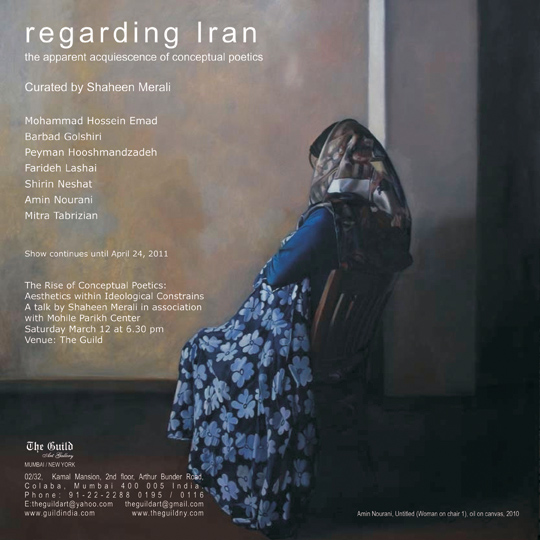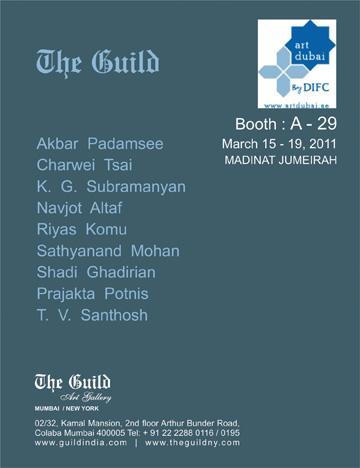
Monday, March 28, 2011
Monday, March 21, 2011
Tuesday, March 15, 2011

In the form of a road movie across 3 continents (Europe, South America, Asia), each stage along the Indian Highway is the occasion for a totally new episode. After London, Oslo and Herning, Lyon staged the fourth episode on 2000 m2, the exhibition presents a panorama of contemporary art in India and more than 30 artists.
Ayisha Abraham, Ravi Agarwal, Sarnath Banerjee, Hemali Bhuta, Nikhil Chopra, Desire Machine Collective, Sheela Gowda, Sakshi Gupta, Shilpa Gupta, Subodh Gupta, N.S. Harsha, Abhishek Hazra, Shanay Jhaveri, Jitish Kallat, Amar Kanwar, Bharti Kher, Bose Krishnamachari, Nalini Malani, Jagannath Panda, Prajakta Potnis, Raqs Media collective (with Debkamal Ganguly, Ruchir Joshi, M. R. Rajan, Priya Sen, Surabhi Sharma (in collaboration with Gautam Singh), Kavita Pai / Hansa Thapliyal and Vipin Vijay for Steps Away from Oblivion), Tejal Shah, Valay Shende, Sudarshan Shetty, Dayanita Singh, Sumakshi Singh, Studio Mumbai + Michael Anastassiades, Kiran Subbaiah, Ashok Sukumaran & Shaina Anand, Thukral & Tagra, Hema Upadhyay.
Friday, March 4, 2011
regarding Iran - the apparent acquiescence of conceptual poetics

regarding Iran
the apparent acquiescence of conceptual poetics
Curated by: Shaheen Merali
Artists: Mohammad Hossein Emad, Barbad Golshiri, Peyman Hooshmandzadeh, Farideh Lashai, Amin Nourani, Shirin Neshat and Mitra Tabrizian
On view till March 31, 2011
The Guild Art Gallery is pleased to present regarding Iran the apparent acquiescence of conceptual poetics curated by Shaheen Merali, opening on March 11th 2011. It is the third exhibition of an ongoing curatorial initiative that has so far been produced in two different countries. Thus far, the curator, Shaheen Merali, has worked with Kunsthalle Brot, Vienna for The Promise of Loss and at the Tokyo Gallery for The Stalking of Absence, to present work by artists that investigates and provides a generous account of Iran’s contemporary situation. The aesthetic inventions of these artists provide exciting probabilities for an inquiring audience to develop an understanding of issues pertaining to Iran and its contested place in the world.
For The Guild, Mumbai, eight artists’ work from within and without Iran is presented as a medium scale group exhibition opening on Friday, the March 11, 2011, close to the occasion of the Persian new year; Norouz. The research for this exhibition involved both studio visits and some remote conversations, finally curating the artists’ works for the first ever presentation of work in India by these contemporary artists who live and work in Iran and also in England and the USA.
Much of the artists’ work is found in the International arena of a visual culture that is affected by a sense of belonging and longing that permits specific identity politics that are conclusively inflected and wrapped in assemblages, based on taking an ethical position encased within a poetic distance.
The curatorial position has considered the following two observations:
i) Curating any regional or ethnic domain, including that of Iran, is made difficult by the sophisticated, cultural palimpsest of the region, its traditions and its people, although it is still important, even necessary, to evaluate its specific aesthetic and cultural developments.
ii) Historically, the country is of ontological importance and has been a domain of highly discursive thinking within its expanses. In its present constellation, Iran has suffered and endured many different circumstances and faced specific challenges from a range of biased nations and religiosities; this, combined with its own reactive epithet, provides for a very pertinent set of conditions which enables the production as well as sets down the role and rules, of aesthetics which have had to function, until now, within a curtailed freedom.
An evolutionary aesthetics of adaptation and an approved cultural code has emerged. Within this curtailment of immobilised consent and the threat of the eradication of dissenting voices, a new formula of the putative whole has emerged, an increasingly conscious alphabet of poetic and political conjunctures.

